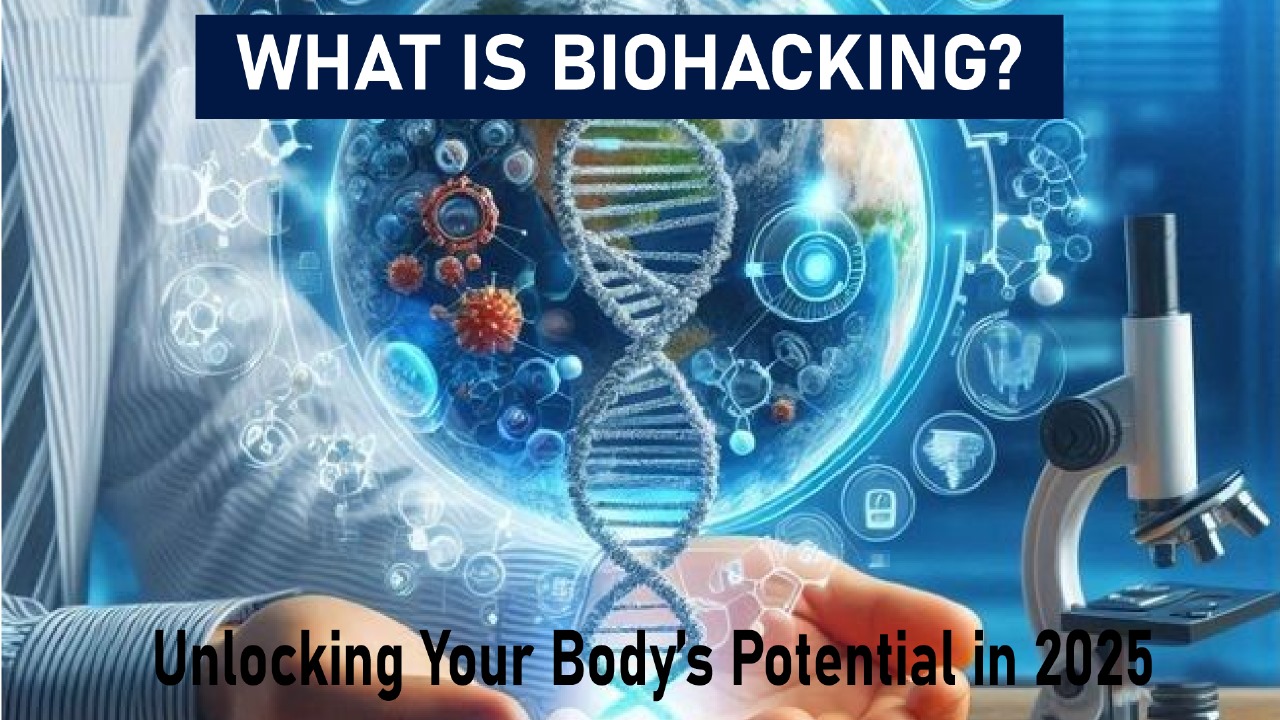Imagine waking up with razor-sharp focus, boundless energy, and a frame that feels years younger—all with out counting on brief fixes or gimmicks. This is the promise of biohacking, a motion that`s taken the well-being global with the aid of using storm. But what’s biohacking exactly? At its core, biohacking is prepared taking manipulate of your biology thru science, technology, and self-experimentation to optimize your physical and highbrow performance. Whether it`s tweaking your diet, using wearable tech, or exploring cutting-edge therapies, biohacking empowers you to emerge as the exceptional version of yourself.. In this 2025 guide, we`ll dive deep into how biohacking works, proportion particular insights, and offer actionable hints to get started. Ready to liberate your potential? Let`s explore.
What Is Biohacking? Defining the Movement
Biohacking is an extensive time period that encompasses diverse techniques of self-optimization, mixing biology, technology, and data-driven experimentation. It’s rooted within the concept that small, specific tweaks for your way of life can result in sizable enhancements in:
- Physical performance (strength, endurance, recovery)
- Mental clarity (focus, memory, creativity)
- Longevity (slowing aging, decreasing disorder risk)
- Emotional well-being (pressure management, temper regulation)
Biohackers vary from informal lovers monitoring their sleep with an Oura Ring to hardcore experimenters using gene-modifying gear like CRISPR (even though the latter remains arguable and in large part confined to labs).
The Three Main Types of Biohacking
- DIY Biology (Grinder Biohacking)
- Extreme self-experimentation (e.g., implanting microchips, nootropics, DIY gene therapy).
- Often controversial due to safety risks.
- Lifestyle & Nutrition Biohacking
- Optimizing diet (keto, intermittent fasting), sleep, and e
- xercise.
- Using wearables (Whoop, Apple Watch) to track biomarkers.
- Tech-Driven Biohacking
- Advanced tools like red light therapy, neurofeedback, and cryotherapy.
- Leveraging AI and biometric data for personalized health insights.
Most people start with lifestyle biohacking—small, safe changes that yield big results.

How Does Biohacking Work?
Biohacking depends on the principle of self-testing. The typical cycle looks like this:
- Define a Goal: Better sleep, increased focus, weight loss.
- Test a Variable: Change one habit, introduce a supplement.
- Track Results: Use apps or wearables to monitor metrics.
- Optimize: Adjust based on feedback.
This loop mimics the scientific method and often includes data-driven tools to ensure accuracy.
For instance, someone experimenting with blue light exposure at night might:
- Wear blue light blocking glasses after 8 p.m.
- Track sleep quality via the Oura Ring.
- Compare deep sleep stats over a month.
The result? Better understanding, better sleep.
What Sets Biohacking Apart in 2025
Biohacking is not just a good trend of good—it is a change of mind. Here are some unique perspectives that make it stand out:
1. Personalization Over One-Size-Fits-All
Unlike conventional fitness advice, biohacking rejects regularly occurring solutions. A 2024 examination from Stanford Medicine discovered that customized vitamins primarily based totally on genetic and microbiome statisticsrmed well-known nutritional guidelines. Biohackers use gear like DNA checking-out kits to tailor interventions to their particular biology.
Fresh Perspective: I soon accompanied a famous healthy diet weight-reduction plan and felt worse in spite of its rave reviews. Biohacking taught me to concentrate on my body’s signals—like how gluten spikes my inflammation—instead of following blanket advice.
2. Technology as a Game-Changer
In 2025, biohacking was turbocharged by technology. AI mobile devices analyze your data and propose personalized adjustments. For example, the level of health use of CGM data to propose foods stabilized in blood sugar. Meanwhile, the interface of the brain and nerve manager transfers the limits of awareness improvement, although they are still tested.
3. Community and Collaboration
Biohacking is prosperous in communities such as R/Biohacking or the Biohacker Reddit summit, where enthusiasts share experiences and results. This collective knowledge accelerates the process because you do not invent the wheel.
Personal anecdote: Joining a biological forum introduced me to red light. After six weeks of daily sessions, my joint pain has decreased significantly—a victory that I will not discover alone.
4. Ethical and Safety Considerations
Not all biohacking is risk-free. Extreme practices like DIY gene modifying or untested dietary supplements may be dangerous. Experts like Dr. Rhonda Patrick emphasize sticking to evidence-primarily based methods. Always seek advice from specialists for superior interventions like hormone therapy.

Benefits of Biohacking
When practiced responsibly, biohacking can lead to:
- Improved cognitive function
- Better sleep and energy levels
- Enhanced physical performance
- Reduced risk of chronic disease
But perhaps the biggest benefit is self-awareness. Many biohackers report a renewed connection with their bodies and minds.
Risks and Ethical Concerns
Biohacking isn’t without drawbacks.
- Lack of regulation in supplements and devices.
- Potential for harm when experimenting with untested interventions.
- Data privacy concerns with tracking tools.
There’s also a bioethics debate around technological enhancements. Where do we draw the line between optimization and overreach?
Table: Safe vs. Risky Biohacking Techniques
| Technique | Category | Risk Level | Recommended For Beginners |
| Intermittent Fasting | Nutritional | Low | ✅ Yes |
| Sleep Tracking | Lifestyle | Low | ✅ Yes |
| Nootropics (e.g. L-theanine) | Nutritional | Medium | ✅ With caution |
| Cryotherapy | Lifestyle | Medium | ✅ Yes |
| RFID Chip Implant | Technological | High | ❌ No |
| DIY Gene Editing | Technological | Extreme | ❌ No |
Visualizing Biohacking: A Sample Weekly Plan
To deliver biohacking to life, here’s a beginner-pleasant weekly plan:
- Monday: Start a 16:8 intermittent fasting schedule (devour inside an eight-hour window).
- Tuesday: Try a 10-minute bloodless bath to reinforce steam and alertness.
- Wednesday: Use a wearable to track sleep and intention for 7-8 hours.
- Thursday: Experiment with a nootropic like caffeine + L-theanine for focus.
- Friday: Practice 10 minutes of mindfulness meditation through Calm.
- Weekend: Review facts out of your wearable and alter one habit (e.g., lessen late-night time display time).
Infographic Idea: A flowchart showing “Start → Track → Experiment → Optimize → Repeat” should visually seize the biohacking process.
Conclusion
Biohacking is not just a fashion word—it is a strong way to support your health and performance. By combining science, technology, and self-testing, you can unlock the potential of the body in a way you will never think is possible. Whether you optimize your diet, follow sleep, or explore advanced therapies, it is important to start small, measure results, and stay curious.
Explore our other resources on Health Zone Club. What’s your first biohacking experiment going to be? Share your thoughts in the comments or dive into our related posts on wellness trends for more inspiration. Ready to transform your life? Subscribe for weekly tips and join the biohacking revolution today!




